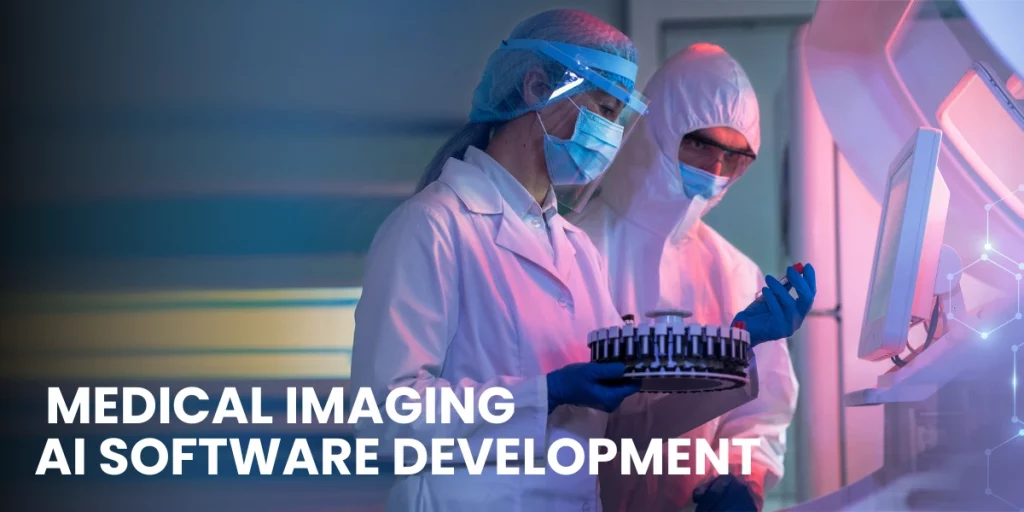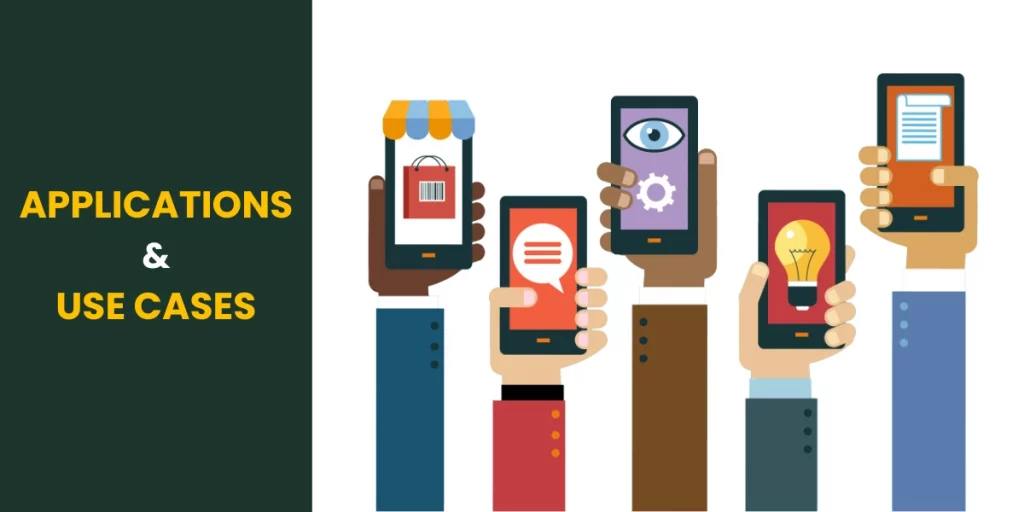Imagine a world where a quick scan can identify existing health problems and predict future issues before any symptoms arise. This is the transformative potential of Medical Imaging AI software development, where advanced technology meets healthcare innovation. By integrating artificial intelligence with medical imaging, this field provides healthcare professionals with powerful tools to detect diseases more accurately, quickly explain images, and discover hidden patterns in X-rays, CT scans, and MRIs.

Why It Matters:
- Precision Diagnostics: AI systems help radiologists by identifying anomalies that may be missed during manual reviews. This results in quicker and more accurate diagnoses.
- Time Savings: Automating routine image analysis tasks saves time, enabling specialists to concentrate on critical cases and enhancing the overall efficiency of healthcare systems.
- Enhanced Patient Care: AI can analyze large amounts of data, allowing doctors to create more personalized treatment plans using detailed imaging information.
The development of these technologies isn’t just about coding smarter algorithms. It is about saving lives and redefining the boundaries of modern medicine.
Table of Contents
Key Technologies in Medical Imaging AI Software Development
The magic of Medical Imaging AI software development lies in its ability to turn complex medical images into meaningful insights that save lives. This transformation became possible through a combination of advanced technologies that not only mimic human expertise but often exceed it. Deep learning algorithms that detect subtle patterns and development frameworks form the basis of innovative diagnostic tools. By understanding these technologies, we can truly see how AI is changing the face of healthcare for the better!
1. Deep Learning (DL):
Deep learning is a key technology in AI imaging, primarily driven by Convolutional Neural Networks (CNNs). These algorithms analyze images by recognizing patterns, such as identifying a broken bone or a tumor, after being trained on thousands of samples. As they process more data, their accuracy improves, making deep learning essential for diagnosing complex medical conditions.
2. Generative AI:
Generative Adversarial Networks (GANs) are transforming AI in medical imaging by generating synthetic images that are highly realistic. This solves a common problem in healthcare: limited datasets. With GANs, developers can train AI models on a wider range of scenarios, enhancing the accuracy of diagnoses for rare or unusual conditions.
3. Natural Language Processing (NLP):
NLP plays a vital role in integrating imaging data with text-based reports. BBy looking at radiology descriptions and matching them up with images, NLP helps AI give a complete picture of patient info. For example, it can link phrases like “possible pulmonary nodule” to its exact location in a C For instance, it can connect phrases like “possible pulmonary nodule” to where it actually shows up in a CT scan.
4. Computer Vision:
Computer vision drives tasks like segmentation (outlining organs or abnormalities), classification (labeling scans as normal or abnormal), and detection (pinpointing specific issues). These capabilities make AI an invaluable assistant to radiologists, enhancing precision and saving time.
5. Frameworks and Standards:
- MONAI: Tailored for healthcare, MONAI simplifies the development of AI models by offering pre-built tools for image pre-processing, segmentation, and training.
- DICOM: The universal standard for medical imaging, DICOM ensures AI applications integrate seamlessly into hospital systems like PACS, enabling efficient workflows.
By weaving these technologies together, Medical Imaging AI software developers create intelligent tools that detect diseases, predict outcomes, and transform patient care.
Development Frameworks and Tools
Developing reliable and efficient Medical Imaging AI software requires robust frameworks and tools designed specifically for healthcare applications. These frameworks streamline development by providing pre-built components, simplifying data handling, and ensuring compatibility with industry standards. Here are the most notable ones:

1. MONAI (Medical Open Network for AI):
MONAI is a domain-specific, open-source framework tailored for medical imaging AI. Built on PyTorch, it provides tools for pre-processing medical images, training deep learning models, and performing advanced tasks like 3D segmentation. MONAI’s integration with healthcare standards like DICOM ensures it fits seamlessly into real-world workflows.
2. TensorFlow and PyTorch:
These general-purpose AI frameworks are widely used for building neural networks. TensorFlow excels in deploying models at scale, while PyTorch is favored for its flexibility in research and experimentation. Both support medical imaging applications with libraries for image recognition and natural language processing.
3. OpenCV (Open Source Computer Vision Library):
OpenCV is a popular library for computer vision tasks. In medical imaging, it aids in image preprocessing, enhancement, and feature extraction, setting the stage for AI models to analyze complex data.
4. DICOM Integration Tools:
Medical imaging relies on the DICOM (Digital Imaging and Communications in Medicine) standard for data storage and transfer. Tools like pydicom allow developers to parse and manipulate DICOM files, ensuring AI applications are compatible with clinical systems like PACS (Picture Archiving and Communication Systems).
5. Cloud Platforms for AI Development:
Cloud services like Google Cloud Healthcare API, AWS Health AI, and Azure Healthcare provide scalable infrastructure for training and deploying AI models. They offer tools for storing medical imaging datasets securely and enabling compliance with healthcare regulations.
6. Federated Learning Platforms:
To address patient data privacy concerns, frameworks like NVIDIA FLARE enable federated learning. This approach trains AI models across decentralized datasets without sharing sensitive information, a critical feature in healthcare AI.
7. Visualization Tools:
Tools like ITK-SNAP and 3D Slicer assist in visualizing and annotating medical images, critical steps for creating high-quality training datasets.
These frameworks and tools empower Medical Imaging AI software developers to build innovative AI solutions that meet the rigorous demands of healthcare, ensuring accuracy, efficiency, and compliance.
Industry Leaders and Their Contributions
The development of Medical Imaging AI software has greatly benefited from the innovative efforts of key companies in the healthcare sector. These organizations create advanced solutions and establish standards for accuracy, efficiency, and regulation compliance.
1. Aidoc: Revolutionizing Radiology
Aidoc specializes in AI-driven radiology solutions, offering tools that prioritize critical cases in imaging workflows. Their FDA-cleared algorithms assist in detecting strokes, fractures, and pulmonary embolisms in real-time, significantly reducing diagnosis delays.
2. Qure.ai: Transforming Emergency Care
Qure.ai develops AI systems tailored for low-resource settings. Their flagship solution, qXR, automates the interpretation of chest X-rays, aiding in the detection of conditions like tuberculosis, pneumonia, and COVID-19. It’s a game-changer in public health and emergency medicine.
3. Cleerly: Advancing Cardiovascular Health
Focused on heart disease, Cleerly’s AI-powered tools analyze coronary CT angiograms to detect and quantify plaque buildup, offering a detailed assessment of cardiovascular risks. Their technology supports personalized treatment plans and preventive care.
4. Zebra Medical Vision: Comprehensive Diagnostics
Zebra Medical Vision’s “AI1” platform provides an all-in-one diagnostic solution covering multiple conditions, from bone health to organ anomalies. Their models are trained on millions of images, ensuring high accuracy across diverse applications.
5. Enlitic: Bridging Radiology and AI
Enlitic focuses on integrating AI into clinical workflows seamlessly. Their flagship product, Curie, enhances radiologist efficiency by sorting, organizing, and analyzing imaging data while ensuring compliance with regulatory standards like DICOM.
6. NVIDIA Clara: Powering AI Development
NVIDIA’s Clara platform offers developers a comprehensive toolkit for medical imaging AI, including pre-trained models, federated learning capabilities, and GPU-accelerated pipelines. It’s widely adopted for research and deployment in clinical environments.
7. PathAI: Pioneering Pathology AI
PathAI applies AI to pathology, enabling precise analysis of tissue samples. Their technology supports better cancer diagnoses and treatment monitoring, complementing radiology-focused AI solutions.
8. Google Health and DeepMind: Research-Driven Impact
Google Health and DeepMind have developed AI tools that analyze retinal scans for eye diseases and mammograms for breast cancer. Their emphasis on research and collaboration with hospitals drives widespread adoption.
9. IBM Watson Health: Early AI Innovator
An early player in medical AI, IBM Watson Health provides AI solutions for imaging, oncology, and genomics. Their offerings aim to integrate data across healthcare systems to deliver holistic insights.
These industry leaders are at the forefront of innovation, each contributing unique solutions that address specific challenges in medical imaging and healthcare at large.
Regulatory and Ethical Considerations
The development of Medical Imaging AI software involves more than just technical advancements. It is essential to follow strict regulations and ethical guidelines to guarantee the safety, accuracy, and fairness of patient care. Since patients’ lives are at risk, developers must deal with issues related to compliance, data privacy, and equity while providing effective solutions. Regulatory approvals confirm that AI tools are safe, and ethical frameworks help tackle biases and build trust with patients.
1. Regulatory Compliance
AI in healthcare must meet standards set by governing bodies like the FDA (U.S.) and CE marking (Europe). These approvals involve rigorous testing of models for safety, accuracy, and reproducibility. Compliance with local healthcare laws ensures that the technology can be deployed effectively in real-world settings.
2. Data Privacy and Security
AI systems rely on large datasets, which often include sensitive patient information. Compliance with privacy laws like HIPAA (U.S.) and GDPR (Europe) is mandatory. Developers use methods like data anonymization and encryption to protect patient data during model training and deployment.
3. Addressing Bias and Fairness
Medical imaging datasets often lack diversity, leading to biases in AI predictions. Developers must ensure their models are trained on data representing all demographics. Regular audits and testing on diverse datasets help minimize bias and promote equitable healthcare outcomes.
This dual focus on regulation and ethics ensures that AI technologies are not only effective but also trusted and accessible to everyone.
Challenges in Medical Imaging AI Software Development
Developing Medical Imaging AI software comes with a unique set of challenges that hinder scalability and widespread adoption. These issues stem from the complex nature of medical data, resource constraints, and the stringent requirements of the healthcare domain. Without addressing these challenges, even the most advanced solutions risk underperforming or failing to meet real-world demands. Developers must tackle technical hurdles, ensure ethical compliance, and streamline clinical adoption to make these systems reliable and effective.
1. Limited and Imbalanced Datasets
Medical imaging datasets are often small and lack diversity. This creates bias in AI models, making predictions less reliable for underrepresented groups. Acquiring and labeling medical images is costly and requires domain expertise.
2. High Computational Requirements
AI model training on medical images demands significant computing power. Access to GPUs, memory, and storage can be prohibitively expensive for smaller organizations. These resource barriers slow innovation and increase development costs.
3. Workflow Integration Challenges
Hospitals use legacy systems like PACS, which AI tools must integrate with seamlessly. Disrupting clinician workflows during deployment reduces adoption. Compatibility and ease of integration are crucial for clinical success.
4. Interpretability and Trust Issues
Many AI models, especially deep learning ones, are complex and lack transparency. Clinicians need clear explanations for AI decisions to trust and use these systems. Developing interpretable models remains a key challenge.
5. Regulatory and Deployment Complexities
Healthcare AI must meet strict regulatory standards like FDA and CE approval. This requires extensive testing, documentation, and validation. Deployment across regions adds complexity due to differing local regulations.
By addressing these challenges, Medical Imaging AI software developers can create impactful AI solutions that are trusted, accessible, and aligned with healthcare demands.
Applications and Use Cases

The development of Medical Imaging AI software has significantly impacted healthcare in various ways, particularly in diagnostics and treatment planning. AI can analyze medical images quickly and accurately, transforming how clinicians identify and manage diseases. These advancements enhance diagnostic accuracy, streamline workflows, and decrease the time required for important decisions. Additionally, AI plays a vital role beyond clinical care by aiding in research, training, and predictive modeling for personalized medicine. The adaptability of AI tools makes them valuable in many medical fields and situations.
1. Automated Disease Detection
AI detects abnormalities such as tumors, fractures, and infections in X-rays, CT scans, and MRIs. It reduces diagnostic errors and enhances accuracy. Early detection leads to timely treatment and better patient outcomes.
2. Image Segmentation and Annotation
AI tools segment organs, lesions, or tumors with precision. This assists radiologists in identifying disease boundaries. Such insights are crucial for surgery planning and targeted therapies.
3. Predictive Analytics
AI analyzes imaging data to predict disease progression or treatment response. Clinicians use these predictions to develop proactive and personalized care strategies. This improves long-term patient management.
4. Workflow Optimization
AI prioritizes critical cases, flagging scans that need urgent review. This accelerates decision-making in emergencies. It also reduces radiologists’ workload by automating repetitive tasks.
5. Research and Training
AI assists researchers by processing large imaging datasets for new discoveries. It creates simulations and case studies for medical training. These tools help trainees practice and understand complex cases.
These use cases highlight how AI drives innovation in medical imaging, delivering faster, more accurate, and reliable healthcare solutions.
Career Path for Medical Imaging AI Software Developers
A career in Medical Imaging AI software development blends expertise in artificial intelligence, medical imaging, and software engineering. Professionals in this field are at the forefront of transforming healthcare, working on innovative solutions that improve diagnostics and patient outcomes. With increasing demand for AI-driven healthcare applications, this career offers exciting opportunities in both research and commercial development. The path requires a solid foundation in computer science and a passion for solving complex medical challenges.
1. Skills Required
Proficiency in AI/ML algorithms and programming languages like Python is essential. Knowledge of medical imaging standards such as DICOM and experience with frameworks like MONAI or TensorFlow are vital. A background in healthcare or biomedical engineering adds value.
2. Roles and Responsibilities
Developers design, train, and deploy AI models for tasks like disease detection and image segmentation. They also work on integrating AI systems with clinical workflows. Ensuring compliance with regulatory standards is a key part of their role.
3. Career Opportunities
Opportunities exist in healthcare AI startups, research labs, and large companies like NVIDIA or Google Health. Roles range from AI engineer and data scientist to software architect. Career growth often leads to leadership or specialized research positions.
By acquiring the right skills and experience, developers can contribute to groundbreaking advancements in healthcare while building a fulfilling career in this rapidly evolving field.
Resources for Aspiring Medical Imaging AI Software Developers
Pursuing a career in Medical Imaging AI software development requires continuous learning and access to the right resources. From online courses to hands-on projects, these resources equip aspiring developers with the skills and knowledge to excel in this cutting-edge field. With the increasing demand for AI in healthcare, there are abundant opportunities to gain expertise through structured programs, open-source projects, and professional communities.
1. Online Courses and Certifications
Platforms like Coursera, edX, and Udemy offer courses on AI and medical imaging. Programs such as Stanford’s AI in Healthcare and Andrew Ng’s Deep Learning Specialization provide foundational and advanced knowledge. Certifications in frameworks like TensorFlow or PyTorch add practical value.
2. Open-Source Tools and Projects
Engaging with open-source projects like MONAI or participating in Kaggle challenges helps developers gain practical experience. These platforms provide datasets and scenarios to practice AI model training and testing.
3. Research Journals and Publications
Keeping up with journals like Nature Medicine, Radiology: AI, or IEEE Transactions on Medical Imaging is crucial. These publications highlight the latest advancements and case studies in AI-driven medical imaging.
4. Networking and Conferences
Events like RSNA (Radiological Society of North America) and MICCAI (Medical Image Computing and Computer-Assisted Intervention) provide networking opportunities. Engaging with these communities helps developers stay updated on industry trends.
5. Specialized Books and Tutorials
Books like Deep Learning for Medical Image Analysis and AI for Radiology provide in-depth insights. Tutorials on GitHub and AI developer forums are excellent for hands-on learning.
By leveraging these resources, aspiring developers can build the skills needed to contribute to transformative AI solutions in healthcare.
Why Choose QwertyExperts.com for Medical Imaging AI Software Development?
When venturing into the cutting-edge domain of Medical Imaging AI software development, having a trusted partner like QwertyExperts.com can make all the difference. QwertyExperts specializes in delivering tailored AI solutions for healthcare, leveraging deep expertise in artificial intelligence, medical imaging, and regulatory compliance. Whether you’re looking to build diagnostic tools, optimize workflows, or create predictive models, their team ensures seamless execution from concept to deployment.
1. Expertise You Can Trust
QwertyExperts boasts a team of seasoned developers with extensive experience in healthcare AI. Their knowledge of frameworks like MONAI and compliance with medical standards like DICOM ensures robust and scalable solutions. Learn how their offshore development teams can support your AI projects efficiently.
2. Tailored Solutions for Your Needs
Every healthcare organization has unique challenges. QwertyExperts offers custom AI development services to meet specific goals, whether it’s automating diagnostics or enhancing patient management systems.
3. End-to-End Development Services
From data collection and model training to deployment and workflow integration, QwertyExperts provides a complete development lifecycle. Their proven success stories highlight their ability to deliver impactful solutions that transform healthcare operations.
4. Dedicated Support and Maintenance
QwertyExperts doesn’t just deliver solutions; they partner with you for long-term success. Their dedicated support team ensures your AI tools remain updated, compliant, and effective in real-world settings.
5. A Proven Track Record
With a portfolio of successful projects in healthcare AI, QwertyExperts has established itself as a trusted leader. Their commitment to innovation and client satisfaction drives results that make an impact.
Ready to transform your medical imaging capabilities with cutting-edge AI solutions? Visit QwertyExperts.com today and take the first step toward revolutionizing healthcare.
Wrapping Up
The advancements in Medical Imaging AI software development are revolutionizing healthcare, offering unprecedented accuracy and efficiency in diagnostics and treatment planning. As a leader in this transformative field, QwertyExperts is your trusted partner to bring these innovations to life. Whether you’re looking to automate workflows, improve diagnostic accuracy, or create predictive models, their expertise ensures success.
Why Partner with QwertyExperts?
- Proven track record in delivering tailored AI solutions for healthcare.
- Expertise in advanced frameworks like MONAI, TensorFlow, and PyTorch.
- Commitment to compliance with industry regulations like HIPAA and GDPR.
- Dedicated support for seamless integration with your existing systems.
Ready to Transform Your Vision into Reality?
Take the next step in advancing your healthcare solutions by partnering with a trusted leader. Explore our success stories or learn more about how our offshore development teams can accelerate your project.
Contact QwertyExperts today to discuss your goals and unlock the potential of AI-driven healthcare innovation.
FAQs
1. How does AI improve medical imaging diagnostics?
AI enhances diagnostic accuracy by analyzing medical images like X-rays, MRIs, and CT scans with exceptional speed and precision. It can detect subtle patterns that may be overlooked by the human eye, enabling earlier detection of conditions like cancer, fractures, or neurological disorders. AI tools also automate repetitive tasks, giving radiologists more time to focus on complex cases.
2. What is the typical development timeline for medical imaging AI software?
The development timeline varies based on project complexity but generally involves several phases:
- Data collection and preprocessing (2-4 months)
- Model training and testing (3-6 months)
- Integration with clinical workflows and regulatory approvals (4-6 months or more) Partnering with an experienced team like QwertyExperts can streamline the process significantly.
3. How does QwertyExperts ensure compliance with healthcare regulations?
QwertyExperts follows stringent protocols to meet industry regulations like HIPAA, GDPR, and FDA standards. Their team ensures data privacy through encryption and anonymization while rigorously testing software for safety and reliability. Learn more about their approach through their success stories.
4. Can AI tools integrate with existing hospital systems like PACS?
Yes, AI systems developed by QwertyExperts are designed to integrate seamlessly with existing hospital infrastructures like PACS (Picture Archiving and Communication Systems). This ensures smooth adoption without disrupting current workflows.
5. How can I get started with Medical Imaging AI development for my organization?
Start by defining your goals, whether it’s automating diagnostics, optimizing workflows, or creating predictive models. Reach out to QwertyExperts to discuss your needs. Their dedicated offshore development teams can guide you from concept to deployment.






